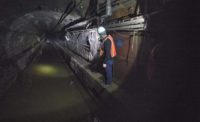Coronavirus and Construction
California Counties Detail Work Resumption Rules, But Questions Remain

Questions remain on jobsite safety rules after health officers in seven San Francisco Bay municipalities announced that all construction could reopen on May 4 under updated shelter-in-place orders.
Contractors and industry groups are concerned about the feasibility of mandates for new safety protocols in place of social distancing standards, which includes third-party COVID-19 accountability supervisors and staggered shifts.
Under the new orders, construction projects can resume if they comply with the new safety protocols, the counties of Alameda, Contra Costa, Marin, San Francisco, San Mateo and Santa Clara and the City of Berkeley said jointly on April 29. Each county and Berkeley issued a separate order with similarly worded language.
Safety Rules Vary
But required safety protocols, detailed in the appendix to each order and varying among the countries, differ from social distancing requirements.
The Santa Clara order appendix, for example, lays out a three-page small construction project safety protocol and a five-page large construction project safety protocol.
Read details of county safety protocols:
- Alameda Order with Safety Protocols
- Contra Costa Small Construction and Large Construction Safety Protocols
- Marin Small Construction and Large Construction Safety Protocols
- San Francisco Order with Safety Protocols
- San Mateo Small Construction and Large Construction Safety Protocols
- Santa Clara Small Construction and Large Construction Safety Protocols
- City of Berkeley Order with Safety Protocols
“We consider this a victory for construction workers who want to get back to work and we believe that our voices have been listened to,” says Tim Paulson, secretary-treasurer of the San Francisco Building and Construction Trades Council, a group of 28 construction unions affiliated with the AFL-CIO. “We expect the job sites we return to will be safe or even safer than before the pandemic.”
While some members lost jobs due to the response to the pandemic, Paulson says they are ready to get back to work. “There were members who lost their jobs for no reason other than the directives, but it wasn’t as deep as we thought it would be,” he says.
For ENR’s latest coverage of the impacts of the COVID-19 pandemic, click here
Industry groups including Associated Builders and Contractors of Northern California, Associated General Contractors of California and United Contractors objected to the safety protocols’ requirement for a third-party jobsite safety administrator who must hold a 30-hour OSHA certificate and have first-aid training.
The onsite administrator would verify protocol compliance through visual inspection and random interviews of workers, with written reports to be made available to counties, if requested. The onsite role would apply to “large construction” projects, which the orders deem as projects with five or more workers..
“We are still unsure of how this would be done and why they think it’s necessary,” says Emily Cohen, executive vice president of United Contractors. “There are simply not enough safety professionals in the Bay Area to perform the specific duties. Not even close.”
A spokesperson for the San Francisco Joint Information Center tells ENR that projects must comply with the new protocols to proceed. The third-party supervisor does not need to be on site for projects to start, “but must be ready to make site visits shortly thereafter."
The spokesperson states that a company can use a third party or train an existing employee as needed for the role. "Projects can continue, and should make steps to have such a supervisor shortly.” he says.
New Onsite Compliance Roles
At this time, San Francisco County does not have a system to train or identify third-party safety supervisors, and suggests that industry groups may be able to do so.
The requirement to stagger trade-specific work is intended to minimize the number of workers on a site, the spokesperson says, adding that it's “not an absolute requirement to stagger all trades at all times, because in some instances more than one trade will be necessary to be on site.” In such instances, the county directs the project to minimize workers on site at one time as much as possible.
The decision to allow all construction to go forward was made with input from industry stakeholders “which made clear that they could implement safety rules necessary to maximize safety for their workers and the community,” says the county.
It expects to issue safety protocols for public works projects that will be similar to the small construction and large construction requirements.
A spokesman for Contra Costa County tells ENR that it, along with other counties, surveyed sample guidelines from the building trades and construction companies to develop its safety protocols, and that “nearly all elements of the protocols in the two appendices can be found in those examples from industry.”
Karl Fischer, county public information officer, says safety protocol compliance is important to ensure worker and community safety, and the county anticipates it may take contractors “some period of time” to implement.
“The expectation is that contractors will take the protocols seriously and make efforts to implement them quickly,” he says in an email to ENR.
The other counties and Berkeley did not immediately respond to requests for more information. Santa Clara County referred inquiries to its April 28 press conference.
Contractors are nimble and sharing best practices, says Michele Daughtery, president and CEO of the ABC chapter, who pointed to the orders’ mandate for jobsites to have a COVID-19 safety compliance officer in addition to the third-party supervisor.
Some contractors may hire third-parties for the compliance officer role and some hope their insurance underwriter will provide a roaming safety reviewer for the other mandated role.
“The way we read it is the [jobsite safety administrator] performs periodic inspections and the [compliance officer] needs to be onsite fulltime,” Daughtery says. She adds that several temporary labor supply firms already are advertising that they can supply compliance officers and that some contractors are hiring safety consulting firms trained in OSHA-30 and first aid to fill the roles.
Essential Worker List Expands
Also, on April 28, the California State Public Health Officer modified its List of Essential Critical Infrastructure Workers.
While construction was already deemed essential under the state order, the health officer added a new category of workers described as those in “Industrial, Commercial, Residential, and Sheltering Facilities and Services.”
The category includes workers who support construction, operation, inspection, and maintenance and workers who support the supply chain of building materials from production through application and installation, among many others such as plumbers, electricians, hardware store workers and warehouse operators.



